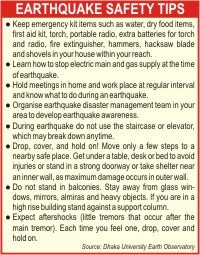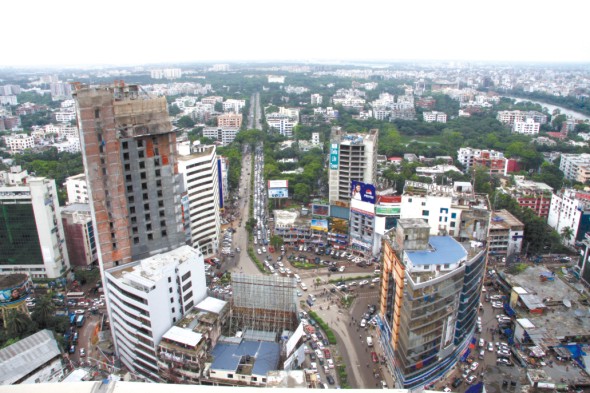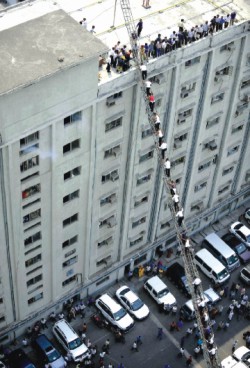|
Current Affairs
DOES THE COUNTDOWN BEGIN?
A big quake can take place anytime.
So the question is not so much of a
looming tremor as of how well
prepared and informed we are.
Rifat Munim
 |
Photo: Zahedul i khan |
Shahana Sumi, who lives in an apartment on the sixth floor of a building in Lalmatia, was trying to lull her newborn to sleep at around half past eleven on the night of September 10, when a tremor all of a sudden started to vibrate the building. It left Shahana bewildered as to what to do with the six-month-old baby in the face of such a disaster, which might plunge everyone into the abysmal debris of a collapsed building just in the blink of an eye.
“We were so unprepared for such a tremor that all we could do was just pace up and down the door, holding the baby tightly in my arms,” says Shahana. She thinks that not only the terror of an impending disaster but also the sheer lack of knowledge as to how to deal with such a situation has left people at their wit's end.
Two consecutive tremors in the span of less than one hour on the eve of Eid and another mild one on the Eid day hit the country making a whole lot of people panic-stricken like Shahana. It has also raised serious concerns about public safety, as most experts believe that these little tremors may be precursors to a big one.
 |
Many of the high-rise buildings in downtown Dhaka are
still being built without maintaining the Bangladesh
National Building Code, jeopardising their safety in the
case of a big tremor. |
In the wake of these moderate tremors, along with the problems to be faced by the good number of the city buildings, which were built turning a blind eye to the national building code, our preparations on the individual, local and national level have become a hotly debated issue in recent times.
However, Professor Jamilur Reza Chowdhury, former vice-chancellor of BRAC University and president of Bangladesh Earthquake Society, refers to a number of such low level tremors in other countries including the USA and comes to the conclusion that the reported earthquakes do not in any way implicate a disastrous one.
“Many people are being fed the information that these little tremors are foreshocks that may lead to a very big earthquake. Such information would at its best create panic among the city dwellers because these little ones do not indicate that a big one is imminent,” Chowdhury says, “In fact, a big quake can take place anytime. So the question is not so much of a looming tremor as of how well prepared and informed we are of the whole thing.”
Professor Syed Humayun Akhter of Geology Department at Dhaka University reverberates Chowdhury when he says, “An earthquake usually occurs when the tectonic plates move sliding past or bumping into each other along their edges known as boundary plates which are made up of several fault lines. As the tectonic position of Bangladesh is at the junction of several plate boundaries, there must be big earthquakes in Bangladesh sooner or later. So all we should focus on is a very strong preparation on the part of the government.”
The Bangladesh National Building Code (BNBC-1993) addresses this by dividing the country into three zoning maps based on the fault lines found in and along the borders of Bangladesh.
According to the zoning maps, the districts that fall in the highly risky zones for the Dauki fault lines along the Bangladesh-Meghalaya border are : Sylhet, Rangpur, Mymensing and Comilla. Chittagong and its adjacent areas, and Dhaka are within the purview of medium risk zones for the plate boundary faults in the Bay and the Madhupur blind fault respectively.
Some 142,000 among 180,000 buildings in Chittagong; 24,000 out of 52,000 in Sylhet; and 78,000 out of 326,000 buildings in Dhaka were detected as risky against an earthquake measuring 7 or above on the Richter scale, according to a recent study conducted by the Comprehensive Disaster Management Programme under the food and disaster ministry.
 |
Photo: Zahedul i khan |
Given this, a lot of pre-emptive measures to lessen the degree of the damages and losses likely to be caused by the ground acceleration during the tremor must be given utmost priority. But what is most ironic about the preventive measures is that the establishments such as schools, hospitals and fire services- which are meant to provide shelter, medical services and rescue operations in the aftermath of a tremor- are themselves highly vulnerable to high scale tremors, most of them being unable to survive a big earthquake.
“There are two phases of the safety measures; in the first phase a set of initiatives are taken before the tremor while the second phase mainly includes the rescue operations requiring that fire and medical services will always be available. Ironically enough, in the event of a big tremor all the fourteen fire service stations in Dhaka will collapse,” says Chowdhury.
Dhaka Medical College Hospital, the biggest hospital in the country, is more than one hundred years old and is likely to crumble even after a moderate tremor. So is the condition of most of the government hospitals responsible for providing treatment in the post-tremor situation.
Asked about the vulnerability of the fire service stations and the dilapidated condition of many hospitals, Mokhlesur Rahman, secretary of food and disaster management ministry, says, “The fire service stations and the hospitals will be retrofitted as soon as possible. We have asked the PWD and the health ministry to take immediate steps in this regard. This year we are taking up a 64 crore project to equip ourselves with all the modern tools for retrofitting and other rescue operations.”
 |
Arranging such fire drill exercises is very
important to train people about what to do
during an earthquake. |
Under the project, he mentions, nearly 62 thousand volunteers will be trained up to gear up rescue operations if necessary.
In order to tackle the post-tremor situations more effectively, Professor Akhter stresses that a nationwide campaign on the part of the government and non-government organisations is indispensable to make people aware of what to do before, during and after the earthquake.
“Holding earthquake drills and meetings in one's home and work place, and organising earthquake disaster management team in one's area to develop awareness and train for post earthquake relief operation is very important,” Akhter says. “Media, in this regard, can play the most important role.”
Apart from these steps related to the second phase, experts unanimously voice another set of initiatives, which must be taken up immediately to save us from a life-threatening disaster.
“All new buildings must be designed according to the BNBC in the first place. It also should be remembered that building vibration is amplified if the structure is built on soft soil. So we should not opt for the recently filled in and low-lying areas for constructing new buildings. In order to work to that end, Rajuk should get over with its manpower problem,” Chowdhury says.
Identifying the weak buildings and determining whether retrofitting those is financially viable should be highlighted in the second place. If the act of retrofitting requires almost a half of the original cost, then it may be more economical to demolish the building and go for a properly designed building. However, taking into consideration the huge number of buildings mentioned above, one can easily assume that such a Herculean task will take a few decades, a fact which in turn begs the question what if a big quake takes place before that?
“Retrofitting (which roughly translates to fitting a new device in an old structure to make it earthquake resistant) and ensuring safety to the buildings is a time consuming process. Therefore, in the event of a big tremor we should be mentally prepared for a large-scale disaster leading to death and injury of thousands of people,” says Chowdhury.
Referring to a contingency plan for Dhaka, Chittagong and Sylhet, which is taken up by the government in association with USAID and UNDP, he says that under the project the government is procuring modern equipment to rescue people trapped inside a collapsed building.
'Under the project a large number of personnel including engineers and fire service officials are being trained up,' informs Rahman.
Taking cues from the experience of other countries, it comes out that an international networking in matters of rescue operations proves to be helpful even in the case of the technologically developed countries.
“It is really impossible for the government to tackle the whole situation single-handedly. So participation of the NGOs and other institutions is also required,' he adds.
In addition to this, awareness on the individual level is deemed very important so that people, instead of being crammed into the exits of a building or work place, have a very sound knowledge of what to do during and in the aftermath of an earthquake.
Copyright
(R) thedailystar.net 2010
|

